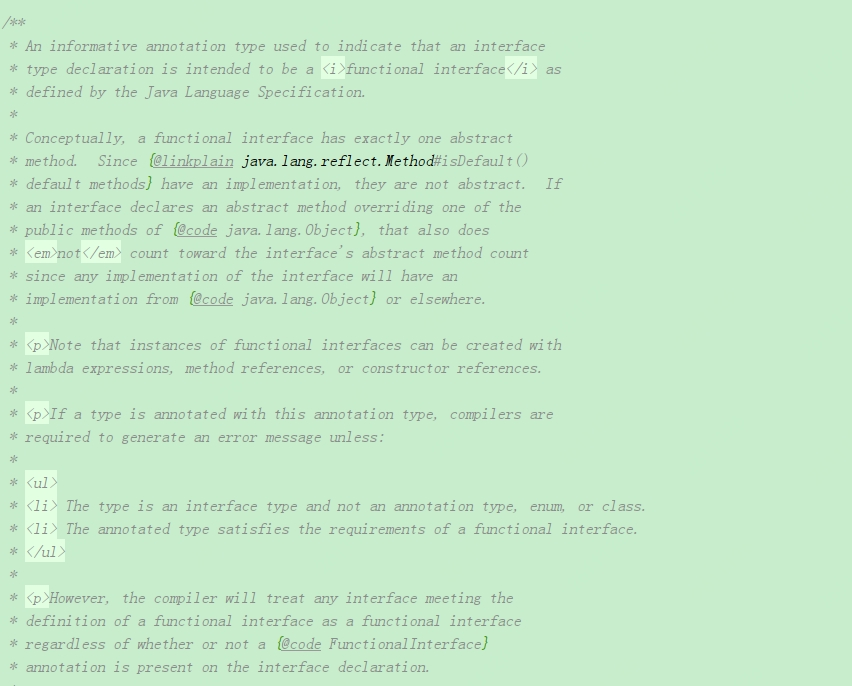Function源码解析与实践
作者:陈昌浩
1 导读
if…else…在代码中经常使用,听说可以通过 Java 8 的 Function 接口来消灭 if…else…!Function 接口是什么?如果通过 Function 接口接口消灭 if…else…呢?让我们一起来探索一下吧。
2 Function 接口
Function 接口就是一个有且仅有一个抽象方法,但是可以有多个非抽象方法的接口,Function 接口可以被隐式转换为 lambda 表达式。可以通过 FunctionalInterface 注解来校验 Function 接口的正确性。Java 8 允许在接口中加入具体方法。接口中的具体方法有两种,default 方法和 static 方法。
@FunctionalInterfaceinterface TestFunctionService{void addHttp(String url);}
那么就可以使用 Lambda 表达式来表示该接口的一个实现。
TestFunctionService testFunctionService = url -> System.out.println("http:" + url);2.1 FunctionalInterface
2.1.1 源码
@Documented@Retention(RetentionPolicy.RUNTIME)@Target(ElementType.TYPE)public @interface FunctionalInterface {}
2.1.2 说明

上图是 FunctionalInterface 的注解说明。通过上面的注解说明,可以知道 FunctionalInterface 是一个注解,用来说明一个接口是函数式接口。 函数式接口只有一个抽象方法。 可以有默认方法,因为默认方法有一个实现,所以不是抽象的。函数接口的实例可以用 lambda 表达式、方法引用或构造函数引用创建。
FunctionalInterface 会校验接口是否满足函数式接口:
类型必须是接口类型,不能是注释类型、枚举或类。
只能有一个抽象方法。
可以有多个默认方法和静态方法。
可以显示覆盖 java.lang.Object 中的抽象方法。
编译器会将满足函数式接口定义的任何接口视为函数式接口,而不管该接口声明中是否使用 FunctionalInterface 注解。
3 Function 接口主要分类
Function 接口主要分类:
Function:Function 函数的表现形式为接收一个参数,并返回一个值。
Supplier:Supplier 的表现形式为不接受参数、只返回数据。
Consumer:Consumer 接收一个参数,没有返回值。
Runnable:Runnable 的表现形式为即没有参数也没有返回值。
3.1 Function
Function 函数的表现形式为接收一个参数,并返回一个值。
3.1.1 源码
@FunctionalInterfacepublic interface Function<T, R> {R apply(T t);default <V> Function<V, R> compose(Function<? super V, ? extends T> before) {Objects.requireNonNull(before);return (V v) -> apply(before.apply(v));}default <V> Function<T, V> andThen(Function<? super R, ? extends V> after) {Objects.requireNonNull(after);return (T t) -> after.apply(apply(t));}static <T> Function<T, T> identity() {return t -> t;}}
3.1.2 方法说明
apply:抽象方法。将此函数应用于给定的参数。参数 t 通过具体的实现返回 R。
compose:default 方法。返回一个复合函数,首先执行 fefore 函数应用于输入,然后将该函数应用于结果。如果任意一个函数的求值引发异常,则将其传递给组合函数的调用者。
andThen:default 方法。返回一个复合函数,该复合函数首先对其应用此函数它的输入,然后对结果应用 after 函数。如果任意一个函数的求值引发异常,则将其传递给组合函数的调用者。
identity:static 方法。返回一个始终返回其输入参数的函数。
3.1.3 方法举例
1)apply
测试代码:
public String upString(String str){Function<String, String> function1 = s -> s.toUpperCase();return function1.apply(str);}public static void main(String[] args) {System.out.println(upString("hello!"));}
通过 apply 调用具体的实现。执行结果:
2)compose
测试代码:
public static void main(String[] args) {Function<String, String> function1 = s -> s.toUpperCase();Function<String, String> function2 = s -> "my name is "+s;String result = function1.compose(function2).apply("zhangSan");System.out.println(result);}
执行结果
如结果所示:compose 先执行 function2 后执行 function1。
3)andThen
测试代码:
public static void main(String[] args) {Function<String, String> function1 = s -> s.toUpperCase();Function<String, String> function2 = s -> "my name is "+s;String result = function1.andThen(function2).apply("zhangSan");System.out.println(result);}
执行结果:

如结果所示:
andThen 先执行 function1 后执行 function2。
identity
测试代码:
public static void main(String[] args) {Stream<String> stream = Stream.of("order", "good", "lab", "warehouse");Map<String, Integer> map = stream.collect(Collectors.toMap(Function.identity(), String::length));System.out.println(map);}
执行结果:
3.2 Supplier
Supplier 的表现形式为不接受参数、只返回数据。
3.2.1 源码
@FunctionalInterfacepublic interface Supplier<T> {/*** Gets a result.** @return a result*/T get();}
3.2.2 方法说明
get:抽象方法。通过实现返回 T。
3.2.3 方法举例
public class SupplierTest {SupplierTest(){System.out.println(Math.random());System.out.println(this.toString());}}public static void main(String[] args) {Supplier<SupplierTest> sup = SupplierTest::new;System.out.println("调用一次");sup.get();System.out.println("调用二次");sup.get();}
执行结果:
如结果所示:Supplier 建立时并没有创建新类,每次调用 get 返回的值不是同一个。
3.3 Consumer
Consumer 接收一个参数,没有返回值。
3.3.1 源码
@FunctionalInterfacepublic interface Consumer<T> {void accept(T t);default Consumer<T> andThen(Consumer<? super T> after) {Objects.requireNonNull(after);return (T t) -> { accept(t); after.accept(t); };}}
3.3.2 方法说明
accept:对给定参数 T 执行一些操作。
andThen:按顺序执行 Consumer -> after ,如果执行操作引发异常,该异常被传递给调用者。
3.3.3 方法举例
public static void main(String[] args) {Consumer<String> consumer = s -> System.out.println("consumer_"+s);Consumer<String> after = s -> System.out.println("after_"+s);consumer.accept("isReady");System.out.println("========================");consumer.andThen(after).accept("is coming");}
执行结果:

如结果所示:对同一个参数 T,通过 andThen 方法,先执行 consumer,再执行 fater。
3.4 Runnable
Runnable:Runnable 的表现形式为即没有参数也没有返回值。
3.4.1 源码
@FunctionalInterfacepublic interface Runnable {public abstract void run();}
3.4.2 方法说明
run:抽象方法。run 方法实现具体的内容,需要将 Runnale 放入到 Thread 中,通过 Thread 类中的 start()方法启动线程,执行 run 中的内容。
3.4.3 方法举例
public class TestRun implements Runnable {@Overridepublic void run() {System.out.println("TestRun is running!");}}public static void main(String[] args) {Thread thread = new Thread(new TestRun());thread.start();}
执行结果:
如结果所示:当线程实行 start 方法时,执行 Runnable 的 run 方法中的内容。
4 Function 接口用法
Function 的主要用途是可以通过 lambda 表达式实现方法的内容。
4.1 差异处理
原代码:
@Datapublic class User {/*** 姓名*/private String name;/*** 年龄*/private int age;/*** 组员*/private List<User> parters;}public static void main(String[] args) {User user =new User();if(user ==null ||user.getAge() <18 ){throw new RuntimeException("未成年!");}}
执行结果:
使用 Function 接口后的代码:
@FunctionalInterfacepublic interface testFunctionInfe {/*** 输入异常信息* @param message*/void showExceptionMessage(String message);}public static testFunctionInfe doException(boolean flag){return (message -> {if (flag){throw new RuntimeException(message);}});}public static void main(String[] args) {User user =new User();doException(user ==null ||user.getAge() <18).showExceptionMessage("未成年!");}
执行结果:

使用 function 接口前后都抛出了指定的异常信息。
4.2 处理 if…else…
原代码:
public static void main(String[] args) {User user =new User();if(user==null){System.out.println("新增用户");}else {System.out.println("更新用户");}}
使用 Function 接口后的代码:
public static void main(String[] args) {User user =new User();Consumer trueConsumer = o -> {System.out.println("新增用户");};Consumer falseConsumer= o -> {System.out.println("更新用户");};trueOrFalseMethdo(user).showExceptionMessage(trueConsumer,falseConsumer);}public static testFunctionInfe trueOrFalseMethdo(User user){return ((trueConsumer, falseConsumer) -> {if(user==null){trueConsumer.accept(user);}else {falseConsumer.accept(user);}});}@FunctionalInterfacepublic interface testFunctionInfe {/*** 不同分处理不同的事情* @param trueConsumer* @param falseConsumer*/void showExceptionMessage(Consumer trueConsumer,Consumer falseConsumer);}
执行结果:
4.3 处理多个 if
原代码:
public static void main(String[] args) {String flag="";if("A".equals(flag)){System.out.println("我是A");}else if ("B".equals(flag)) {System.out.println("我是B");}else if ("C".equals(flag)) {System.out.println("我是C");}else {System.out.println("没有对应的指令");}}
使用 Function 接口后的代码:
public static void main(String[] args) {String flag="B";Map<String, Runnable> map =initFunctionMap();trueOrFalseMethdo(map.get(flag)==null).showExceptionMessage(()->{System.out.println("没有相应指令");},map.get(flag));}public static Map<String, Runnable> initFunctionMap(){Map<String,Runnable> result = Maps.newHashMap();result.put("A",()->{System.out.println("我是A");});result.put("B",()->{System.out.println("我是B");});result.put("C",()->{System.out.println("我是C");});return result;}public static testFunctionInfe trueOrFalseMethdo(boolean flag){return ((runnable, falseConsumer) -> {if(flag){runnable.run();}else {falseConsumer.run();}});}
执行结果:

5 总结
Function 函数式接口是 java 8 新加入的特性,可以和 lambda 表达式完美结合,是非常重要的特性,可以极大的简化代码。











